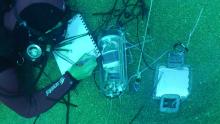Development of measuring instruments
The advantage of scientific diving is the direct access to the object and area under investigation. This allows complex relationships and complicated investigations to be carried out with pinpoint accuracy, in a controlled manner and in a perceptible context.
The same challenges apply to the measuring equipment and aids that are to be used underwater. They must be designed for the corresponding depth and have a sufficiently fast response time and measuring time. In addition, they must be robust and resistant and still provide accurate and reliable values. For a large number of hydrochemical parameters and physical variables, the same measuring devices can be used as for surface water, but with appropriate customisation.
For selected phenomena, there is no existing measurement technology that can simply be used underwater with a housing. It is therefore necessary to develop a special, customised and newly developed methodology or device technology. This, as well as the adaptation of existing measurement technology, is a long-standing competence of the Scientific Diving Centre and forms the basis for effective and reliable investigations in the fields of geology, hydrology and monitoring.
FSVG – Flowmeter for Submarine Vulcanic Gas emission
The FSVG - Flowmeter for Submarine Vulcanic Gas emission demonstrates the highly individualised requirements of measuring device development.
The volcanic area of the "aeolian islands" is a system that is not yet fully understood. Fumaroles (gas outflows) can be observed and measured in this area. In order to make a statement about the behaviour and development of the volcanic system, long-term data of the escaping gas volume flow is required. This data can be used to make predictions about earthquakes and volcanic eruptions and to improve existing warning systems in endangered areas.
The following requirements have arisen for this purpose:
- Long-term measurement of a submarine gas volume flow of volcanic origin over at least 1 year
- Simple installation and use under water
- Maintenance-free, robust, reliable measuring principle
- Resistant to the operating conditions
- Sufficient power supply and data memory
In order to fulfil all of these requirements, various systems were developed, tested and tried out in several student qualification and final theses.
publications / scientific work:
Ponepal, M.:
Konstruktion und Test einer Volumenstrommessanlage für submarine Gasaustritte sowie deren Ertüchtigung für Langzeitmessungen
Projektstudium, TU Bergakademie Freiberg, 2011
Hertwig, M.:
Entwicklung eines Gerätes zur Volumenstrommessung an submarinen vulkanischen Gasaustritten
Diplomarbeit, TU Bergakademie Freiberg, 2013
Stroetmann, M.:
Calibration and interpretation of the monitoring data of asubmarine volumetric flowmeter
Studienarbeit, TU Bergakademie Freiberg, 2014
Pose, S.; Shidowezki, D.:
Weiterentwicklung und Bau des FSVG zur unterseeischen Volumenstrommessung
Projektarbeit, TU Bergakademie Freiberg, 2017
Air-Lift / underwater hoover for scientific diver
In order to uncover concealed structures underwater, a well-known air lift system was adapted for mobile use by scientific divers. The device is operated with diving/compressed air cylinders and can be transported in individual parts and assembled on site. The system has the advantage of reliably displacing sediments without destroying delicate structures that have formed as a result of geological processes, for example.
The system works with a defined quantity of gas that expands in a vertical pipe and thus creates a vacuum. The development and practical testing took place in various lakes in Germany and in the Mediterranean during field work in the hydrothermal system of Panarea, Italy.
Stanulla, R.; Barth, G.; Ganß, R.; Reich, M.; Merkel, B. (2016): Development of a mobile airlift pump for Scientific Divers and its application in sedimentological underwater research. Underwater Technology, 34(1), pp. 39-43. DOI:10.3723/ut.34.039
Measuring instruments and camera technology
In the university's own workshop, highly qualified staff can quickly test and manufacture prototypes and customised housings using the extensive range of machinery. Conventional lathes and milling machines as well as CNC lathes and milling machines can be utilised.
In addition, a co-operation with the company "BS Kinect" made it possible to test carbon housings that were unusual at the time of development. These combine the advantages of high load capacity with low weight.
Sea sediment and soil sampling equipment
When sampling underwater sediments and soils, scientific divers use different methods depending on the objective of the investigation. A horizontally stable sample is required to analyse the soil properties. Sufficient material from the individual horizons is also required in order to determine suitable soil chemistry values.
For this purpose, a procedure and an additional transport device were developed in collaboration with the geotechnical engineering company "terraf".

